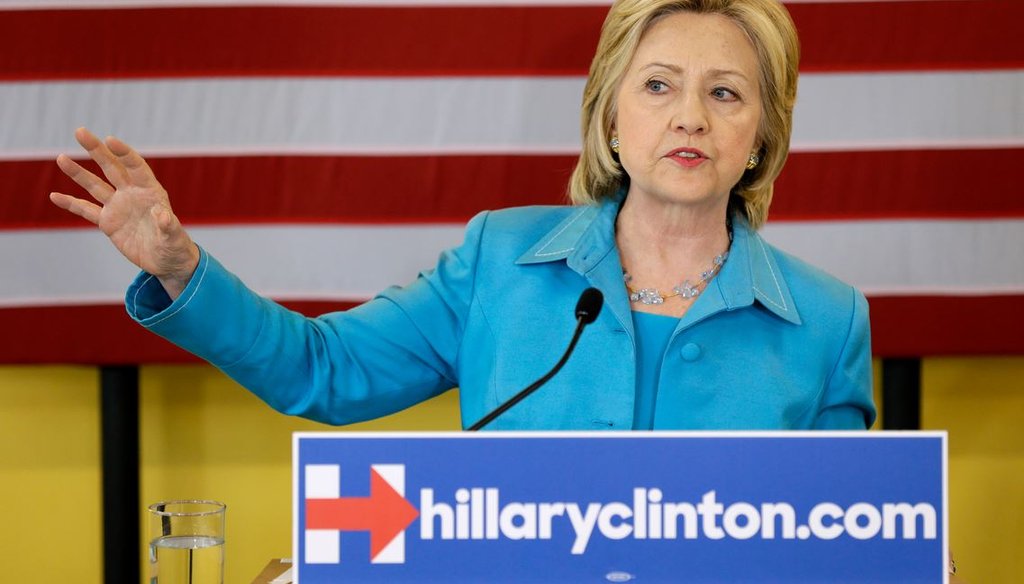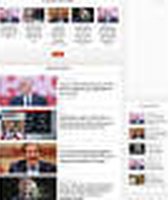Stand up for the facts!
Our only agenda is to publish the truth so you can be an informed participant in democracy.
We need your help.
I would like to contribute

Democratic presidential candidate Hillary Clinton speaks about her renewable energy plan July 27, 2015, in Des Moines, Iowa. (AP Photo/Charlie Neibergall)
Hillary Clinton has said over and over again that there was no classified material on the private email server she used while secretary of state.
"I have said repeatedly that I did not send nor receive classified material, and I’m very confident that when this entire process plays out that will be understood by everyone," she said in Minneapolis in August.
"I can only repeat what happens to be the case-- that I did not send nor receive information that was marked classified at the time that it was sent or received," she said on Sept. 8 in an interview with ABC News.
Is that true? It’s hard to tell definitively, but so far we can’t prove Clinton wrong. We won’t be rating her statement on the Truth-O-Meter now, because investigations are ongoing.
The situation with Clinton’s email is downright confusing though, for several reasons.
Sign up for PolitiFact texts
Federal agencies have the ability to classify information after the fact. So some of the emails weren’t classified when Clinton sent or received them, but they are classified now.
Also, there are rules for handling information from foreign governments. Some of those rules have been confused in media reports. And while Clinton’s team seems to have tried to keep classified information off her server, there are grey areas that they may have missed.
Finally, investigators are still looking into the email server, and we don’t know what their findings will be.
Dealing with classified information
Of the several thousand emails from Hillary Clinton’s private server that have been released to the public, more than 180 have been redacted, meaning they contain information deemed classified. But State Department officials decided only in the past few months that this information should be classified.
This sort of classification upgrade occasionally happens when new information comes into play that affects the sensitivity of the information. Because the information was classified after the emails were sent, no one mishandled this information at the time by sending it over Clinton’s private server.
To send classified information electronically, the State Department has a secure, closed system. So even if Clinton had used a state.gov email address, this would not have been secure enough to transmit classified information. Procedurally, emails would get a label marking them as containing classified information.
Clinton has said she viewed classified information in hard copy in her office. If she was traveling, she used other secure channels.
Some of the emails released this month actually show Clinton’s team talking about how they can’t email each other classified information.
Senior adviser Alec Ross noted in a February 2010 email that he was keeping his comments "within the boundaries of unclassified email… regarding the country we discussed."
In another email that month, long-time Clinton adviser Huma Abedin wrote to Clinton about a call she was scheduled to have with a new Ecuadorian foreign minister, saying "Trying to get u call sheet, its (sic) classified."
Clinton must have encountered classified information as secretary of state on a daily basis, said Liza Goitein, co-director of the Brennan Center for Justice’s Liberty and National Security Program. The emails released so far don’t have labels marking them classified when sent, which supports Clinton’s argument.
"The fact that no emails on her personal server were marked as classified suggests that she generally was doing her classified business on the secure government servers dedicated to that purpose," she said.
Investigations
Because Clinton used a private server, we only have Clinton’s word that she turned over all relevant email. It’s possible there are emails with classified information on them that she deleted or did not turn over.
As for emails turned over and reviewed so far, there’s some interagency squabbling that makes it confusing to sort out what is classified and what is not. Independent inspectors general have said her emails contain some classified intelligence community information, but Clinton’s campaign and the State Department dispute those findings -- saying the information was not classified.
Government agencies regularly disagree over what should be classified or not, and transparency advocates say the government overclassifies. (We talked about this at length in a previous article.) It means, though, that the inspectors general’s findings are not definitive proof that Clinton’s server contained classified information.
Also, there are more than 45,000 emails still to be released publicly. The State Department and the intelligence community, as they review the emails for release, might yet find unquestionably classified information.
Foreign government information
Even though the State Department has said the now-redacted emails were not classified at the time they were sent, Reuters and some others have questioned whether that’s accurate -- primarily because 87 of them contain foreign government information. The State Department’s Foreign Affairs Manual (an employee rulebook) stipulates that foreign government information, if delivered in confidence, must be deemed classified.
Reuters and others point to a November 2009 email containing a memo about Afghanistan written by then British Foreign Secretary David Miliband. In the email -- sent to Clinton aide Huma Abedin, then forwarded to Clinton -- a Miliband aide writes that the memo is intended for Clinton’s eyes "only."
This seems like an obvious indicator that the information was provided in confidence, and thus should be deemed classified, as required by the Foreign Affairs Manual.
"I cannot think of a clearer sign of an expectation that this was to be treated in confidence," former Information Security and Oversight Office director J. William Leonard told our friends at the Washington Post Fact Checker.
But not all experts agree that Clinton’s handling of foreign government information is an obvious violation.
First of all, the confidentiality of the email is not 100 percent clear. Yes, the memo was intended solely for Clinton. But Miliband’s aide sent the email from his own personal account to Abedin at her state.gov email address -- not the State Department’s secure system. The memo also didn’t carry a marker indicating the British equivalent of classification.
If the confidentiality of the information is not explicit, there’s room for disagreement about whether there was a violation, said Steven Aftergood, director of the Project on Government Secrecy at the Federation of American Scientists.
Also, information can’t be classified until someone with the proper authority declares it so. Because the memo didn’t come with an official British classification marker, someone in the U.S. government would have had to make that call. So even if the memo required classification, it was not classified when it landed in Clinton’s email -- meaning it does not necessarily go against the claim that she did not receive classified material, Goitein said.
While Abedin may have misstepped in forwarding the memo along, "Clinton’s own culpability in simply receiving the email is a much murkier question," Goitein said.
Our conclusion
We’ve noticed several Republican candidates claiming that Clinton negligently handled classified information. But they’re jumping the gun. There isn’t enough evidence to prove that. Some evidence suggests Clinton and her team went to some trouble to keep classified information out the email system.
This is not to say Clinton’s email setup was allowed or appropriate -- for example, it skirted open records laws and presents challenges to archivists. And subsequent investigations may yield surprises or other unexpected evidence. But because of the way classification works and because of the incomplete record of her emails, we continue to reserve judgment.
Our Sources
Reuters, "Exclusive: Dozens of Clinton emails were classified from the start, U.S. rules suggest," Aug. 21, 2015
Reuters, "Another 57 Clinton email threads contain foreign governments' information," Sept. 2, 2015
Washington Post, "Clinton’s claims about receiving or sending ‘classified material’ on her private e-mail system," Aug. 27, 2015
Associated Press, "Clinton, aides stressed protecting State Dept info in email," Sept. 1, 2015
The Atlantic, "Should There Be a Criminal Investigation Into Hillary Clinton's Email?" July 24, 2015
PolitiFact, "Four pressing questions about Hillary Clinton’s State Department email,"
State Department, Foreign Affairs Manual 2009, accessed Sept. 10, 2015
State Department, daily press briefing, Aug. 17, 2015
White House, Executive Order 13526- Classified National Security Information, Dec. 29, 2009
Politico, "Hillary fights back on classified emails," Aug. 19, 2015
Email, phone interview, Clinton spokesman Josh Schwerin, Sept. 3, 2015
Email interview, State Department spokesman Alec Gerlach, Sept. 9, 2015
Email interview, Steven Aftergood, Federation of American Scientists, Sept. 4, 2015
Email and phone interview, Liza Goitein, Brennan Center for Justice, Sept. 3, 2015














































